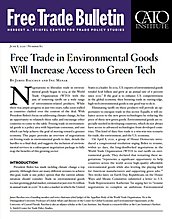1 “Joint Working Party on Trade and Environment: Report on a Set of Policy Indicators on Trade and Environment,” OECD, February 12, 2019.
2 “Environmental Goods Agreement,” Office of the United States Trade Representative.
3 “Expressing the Sense of the House of Representatives That the United States Trade Representative Should Promptly Resume Negotiations to Conclude the Environmental Goods Agreement,” H. Res. 295, 117th Cong. (2021).
4 Letter to Ambassador Katherine Tai from the House Ways and Means Committee Republicans, April 22, 2021, https://gop-waysandmeans.house.gov/wp-content/uploads/2021/04/210421-Letter-EGA-letter-final.pdf.
5 “Biden: No New Trade Agreements until U.S. Has ‘Invested in Americans’,” World Trade Online, January 24, 2020.
6 Joseph R. Biden, “Remarks by President Biden in Address to a Joint Session of Congress” (speech given at the U.S. Capitol, April 29, 2021).
7 “Ministerial Declaration,” adopted November 14, 2001, Ministerial Conference, Fourth Session, Doha, Qatar, November 9–14, 2001, World Trade Organization, WT/MIN(01)/DEC/I, 20 November 2001, paragraph 31(iii).
8 Peter Ungphakorn, “India and South Africa Pour Cold Water on Alternative Approach to WTO Talks,” Trade — Blog, March 30, 2021.
9 “Environmental Goods Agreement,” World Trade Organization, https://www.wto.org/english/tratop_e/envir_e/ega_e.htm.
10 “Annex C—APEC List of Environmental Goods,” Asia-Pacific Economic Cooperation, Vladivostock, Russia, September 8, 2012, https://www.apec.org/Meeting-Papers/Leaders-Declarations/2012/2012_aelm/2012_aelm_annexC.aspx.
11 “Environmental Goods Agreement: Report from the 16th Round of Negotiations,” European Commission, September 10, 2016, https://trade.ec.europa.eu/doclib/docs/2016/october/tradoc_154996.pdf.
12 For a detailed negotiating history, see Global Affairs Canada, “WTO Environmental Goods Agreement (EGA),” December 14, 2016, https://www.international.gc.ca/trade-agreements-accords-commerciaux/topics-domaines/env/plurilateral.aspx?lang=eng.
13 “The APEC List of Environmental Goods,” Asia-Pacific Economic Cooperation Secretariat, November 2012.
14 “Joint Working Party on Trade and Environment: The Stringency of Environmental Regulations and Trade in Environmental Goods,” COM/TAD/ENV/JWPTE(2013)33/FINAL, OECD, November 19, 2014, Annex 1, 51.
15 This was the suggestion of the National Association of Manufacturers in the United States. See Matt Roessing, “Greed Is (an Environmental) Good,” Sidebar (blog), June 27, 2014.
16 Iana Dreyer, “Environmental Goods Agreement—Why Talks Faltered,” Borderlex, December 6, 2016.
17 Jaime de Melo and Jean-Marc Solleder, “Reviving the Environmental Goods Agreement: Why It Matters, Why It Is Stalled, and How to Move Forward.”
18 Maureen Hinman, “Green Goods Market Access Is Key to Biden’s Build Back Better Agenda,” Washington International Trade Association, March 11, 2021.
19 Hinman, “Green Goods Market Access Is Key to Biden’s Build Back Better Agenda.”
20 “Sources: China’s EGA Product Coverage Commitments Lagging,” World Trade Online, April 26, 2016.
21 “Leaked EGA Documents Reveal Differing U.S., China Tariff Phaseout Offers,” World Trade Online, April 27, 2016.
22 Mark Wu, “Why Developing Countries Won’t Negotiate: The Case of the WTO Environmental Goods Agreement,” Trade, Law, and Development 6, no. 1 (2014): 94.
23 “Sustainable Development Goal 9,” United Nations, Department of Economic and Social Affairs, https://sdgs.un.org/goals/goal9.
24 Hanna Bucher, Jane Drake-Brockman, Alexander Kasterine, and Mahesh Sugathan, “Trade in Environmental Goods and Services: Opportunities and Challenges,” International Trade Centre Technical Paper, 2014.
25 See James Bacchus, “Reviving the WTO: Five Priorities for Liberalization,” Cato Institute Policy Analysis no. 911, February 23, 2021.
26 “Joint Statement Regarding Trade in Environmental Goods,” January 24, 2014, World Economic Forum, Davos, Switzerland.
27 “Information Technology Agreement,” World Trade Organization, https://www.wto.org/english/tratop_e/inftec_e/inftec_e.htm.
28 Aaron Cosbey, Soledad Aguilar, Melanie Ashton, and Stefano Ponte, Environmental Goods and Services Negotiations at the WTO: Lessons from Multilateral Environmental Agreements and Ecolabels for Breaking the Impasse (Winnipeg: International Institute for Sustainable Development, 2010), p. 57.
29 For greater details on this and other challenges relating to product classification, see Ronald Steenblik, “Liberalising Trade in ‘Environmental Goods’: Some Practical Considerations,” OECD Trade and Environment Working Paper no. 2005–5, December 16, 2005.
30 The WTO classification includes sewage services, refuse disposal services, sanitation and similar services, and other services (e.g., cleaning services of exhaust gases, nature and landscape protection, etc.).
31 Ronald Steenblik, Dominique Drouet, and George Stubbs, “Synergies between Trade in Environmental Services and Trade in Environmental Goods,” OECD Trade and Environment Working Paper no. 2005–1, July 19, 2005, p. 131.
32 See, in part for a slightly different view, Bernhard Pötter, “TTIP in Green: Free Trade for Ostensibly Eco-Goods,” Green European Journal, June 24, 2016.
33 Bucher et al., “Trade in Environmental Goods and Services: Opportunities and Challenges.”
34 Ronald Steenblik et al., “Synergies between Trade in Environmental Services and Trade in Environmental Goods,” p. 130.
35 “Communication from the United States: Environmental Services,” Council for Trade in Services, Special Session, World Trade Organization, S/CSS/W/25, December 18, 2000.
36 Steenblik et al., “Synergies between Trade in Environmental Services and Trade in Environmental Goods,” p. 149.
37 “Environmental Goods Agreement,” Office of the United States Trade Representative.
38 2019 Top Markets Report: Environmental Technologies: a Market Assessment Tool for U.S. Exporters (Washington: International Trade Administration, 2020).
39 Trade that Benefits the Environment and Development: Opening Markets for Environmental Goods and Services (Paris: OECD, 2005), p. 25.
40 Kornel Mahlstein and Christine McDaniel, The Environmental Goods Agreement: How Would US Households Fare? (Geneva: International Centre for Trade and Sustainable Development, 2017), p. vi.
41 Katherine Tai, “Remarks from Ambassador Katherine Tai on Trade Policy, the Environment and Climate Change,” Office of the United States Trade Representative, April 15, 2021.
42 Biden-Harris Campaign, “The Biden Plan for a Clean Energy Revolution and Environmental Justice,” https://joebiden.com/climate-plan/.



